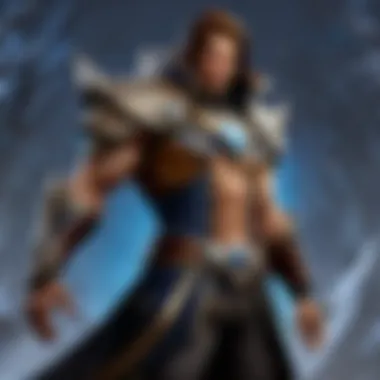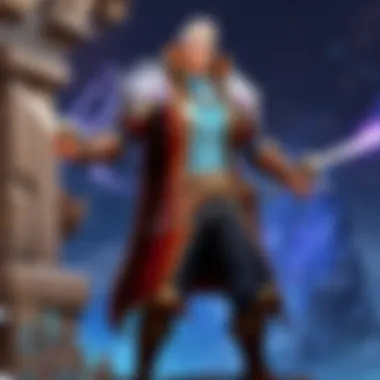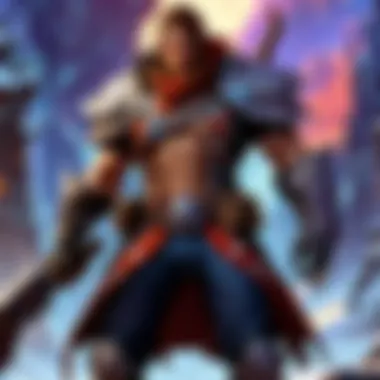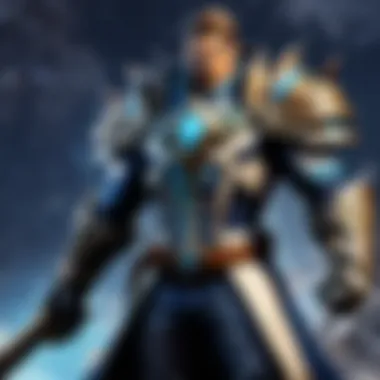Understanding the Role of the Spellslinger in Gaming


Intro
The role of the spellslinger in gaming, particularly within the realm of Blizzard Entertainment's offerings, is an intriguing concept that deserves detailed exploration. Spellslingers are often characterized as magical warriors, blending arcane prowess with combat skills. This connection between magic and physical abilities creates a unique dynamic, challenging players to master not only their spells, but also their combat techniques.
As the gaming landscape evolves, understanding how spellslingers function within different titles is key to appreciating their significance. This article will analyze how Blizzard has tailored the spellslinger archetype across various games, focusing on gameplay mechanics, narrative implications, and community engagement.
Developing effective strategies and adapting to changes in gameplay can enhance the overall experience for both casual players and competitive gamers. The exploration will also shed light on the social aspects surrounding spellslingers, showing their cultural relevance within the gaming community.
The following sections will delve into the recent updates affecting spellslingers, character strategies, and community dynamics, providing a well-rounded perspective on this fascinating role.
Through this comprehensive guide, readers will gain insights on how to engage with the spellslinger persona and utilize its potential within the gaming universe.
Defining the Spellslinger
Understanding the spellslinger is crucial for grasping modern gaming narrative and mechanics, particularly in titles from Blizzard. The term ‘spellslinger’, often associated with characters wielding magical abilities, transcends simple spellcasting. It embodies attributes of agility, strategy, and diverse gameplay that enhances player engagement and immersion. Spellslingers not only contribute uniquely to the storylines but also create dynamic interactions in multiplayer settings, making them versatile in both cooperative and competitive environments.
Origins of the Term
The etymology of spellslinger hints at a rich history in both gaming and literature. Initially, the word emerged to describe individuals skilled at casting spells rapidly, particularly in fantastical contexts. Over time, various role-playing games adopted the term, blending it with distinct character archetypes who specialize in magic. This adaptation allowed the spellslinger to become a staple in franchise games and tabletop RPGs. Their emphasis on quick spellcasting paired with agility has connected them deeply with fans, igniting discussions on gameplay tactics and narrative importance in various settings.
Characteristics of a Spellslinger
To fully appreciate the role of a spellslinger, one must comprehend their defining characteristics. These traits not only shape how players approach the character but also inform strategies within gameplay. The following are notable characteristics of a spellslinger:
- Spellcasting Proficiency: Spellslingers excel in casting spells swiftly and efficiently, making them key players in fast-paced situations.
- Mobility: They often possess enhanced movement abilities, allowing them to dodge attacks while maintaining pressure on opponents.
- Adaptability: Spellslingers can mix different types of magic, making them unpredictable and versatile in strategy.
- Resource Coordination: Effective spellslinger gameplay often relies on managing resources, such as mana or spell charges, making resource management critical to their success.
These characteristics contribute significantly to how a spellslinger interacts within a game ecosystem. Their unique blend of agility and magical skills fosters a distinct style of play that appeals to and challenges gamers.
Gameplay Mechanics Involving Spellslingers
The complexity of gameplay mechanics relating to spellslingers adds depth to the gaming experience, particularly in titles produced by Blizzard. These mechanics not only define how spellslingers operate in the game, but also contribute to strategies and player engagement. Understanding these dynamics is essential for both casual gamers and those looking to compete at higher levels.
Spellcasting Dynamics
Spellcasting is a pivotal component in the gameplay of spellslingers. It involves the mechanics of casting spells, which can include timing, spatial awareness, and target selection. Spellslingers often rely on a variety of spells to adapt to different combat situations. For example, in World of Warcraft, spells may serve various roles such as damage dealing, crowd control, or healing. The choice of spells impacts both the player's strategy and tactics.
Moreover, the animation and casting time associated with spells can create a rhythm in gameplay. Players must learn how to optimize their casting to minimize interruption and maximize damage. This interplay of quick decisions and spell selection is crucial.
"Mastering spellcasting dynamics requires practice and a firm grasp of one's abilities."
Resource Management


Managing resources is vital for spellslingers. Different games feature unique systems for resource expenditure, such as mana or energy. Efficient use of resources ensures a spellslinger can continue to perform actions without interruption. In Hearthstone, for instance, managing mana efficiently can turn the tide in a game by allowing players to cast higher-cost spells when necessary.
Additionally, some spells may consume more resources than others. Understanding which spells to use at critical moments can significantly impact the outcome of a battle. It is crucial for players to balance their resources effectively, ensuring they can access their most powerful spells when they need them the most.
Combat Strategies
Combat strategies for spellslingers revolve around their unique capabilities. Spellslingers must balance aggression with caution, utilizing positioning and spacing to avoid enemy attacks while delivering damage. In Overwatch, for instance, certain spells can allow spellslingers to control the battlefield by creating barriers or dealing area-of-effect damage.
Key strategies include:
- Kiting: Maintaining distance from enemies while dealing damage.
- Burst Damage: Timing spell combinations for maximum impact.
- Peeking: Using cover and positioning to mitigate incoming attacks while striking back.
Spellslingers in Blizzard Games
The role of spellslingers in Blizzard games represents a dynamic aspect of gameplay that enhances player engagement and strategy. Each title in Blizzard's portfolio showcases the spellslinger archetype uniquely, allowing for a multifaceted exploration of magic-based characters and their influence on the game.
Spellslingers in World of Warcraft
In World of Warcraft, spellslingers play a crucial role in various frameworks, from Player vs. Environment to Player vs. Player interactions. The diverse range of spellcasters includes the Mage, Warlock, and Priest. Each class exhibits distinct abilities that fit different styles of play. Mages specialize in direct damage spells and crowd control, exciting players with their high burst damage potentials. Warlocks, on the other hand, manipulate dark arts with their damage-over-time spells and pet mechanics, presenting a strategic battle philosophy. Priests can switch from damage dealer to healer, showcasing versatility. Thus, spellslingers contribute to team composition, impacting raid strategies and arena success.
Spellslingers in Hearthstone
In Hearthstone, the spellslinger archetype is represented through various spells and minions associated with the Mage and Warlock classes. These characters blend strategy and luck, demanding analytical thinking and foresight to decide when to deploy their spells. Cards like Fireball or Hellfire not only represent spellcasting but also involve tactical positioning on the board. Players must consider potential incoming threats while maintaining spell resources. This interplay creates a rich landscape that is both challenging and rewarding. Moreover, the endless combinations in deck building highlight the individual player's creativity, making every game a possibility for unique outcomes.
Spellslingers in Overwatch
In Overwatch, spellslingers appear primarily as characters who wield elemental abilities or magical powers, such as Zarya and Mei. Zarya uses her particles to shield allies while dealing damage, highlighting the blend of offensive and defensive roles. Mei's ice-based skills manipulate the battlefield, freezing opponents or creating barriers. The character designs emphasize a synergy between magic and technology, pushing players to harness these abilities for strategic advantage in team fights. A spellslinger’s choice in Overwatch often shapes the game's dynamics, showcasing the importance of teamwork and effective communication.
"In every Blizzard game, spellslingers bring an essential layer of strategy and excitement that captivates players."
Thus, spellslingers are not just magical characters; they create a vivid tapestry that enriches the overall gameplay experience across Blizzard’s titles. Their diverse roles and mechanics highlight the importance of strategic thinking, creativity, and adaptability in players. Each game presents unique challenges and opportunities, forging a distinct bond between spellslingers and their players.
Narrative and Lore Aspects
In the context of gaming, particularly within the realm of Blizzard titles, the narrative and lore aspects surrounding spellslingers are pivotal. They add depth to the gameplay experience, enriching the player's engagement with the game world. Every spellslinger carries a unique story and background, influencing how they interact with the game environment and other characters. This connection between narrative and gameplay is not merely optional; it is integral in creating a cohesive and immersive gaming experience.
Lore informs players about the universe in which the spellslinger exists. It offers insights into their motivations, personal conflicts, and relationships with other characters. Understanding a spellslinger’s lore can enhance a player’s appreciation of their abilities and choices during gameplay. Additionally, strong narratives often lead to emotional investment, making victories more satisfying and losses more poignant.
Storytelling Through Spellslingers
Striking a balance between combat and storytelling is a challenge in gaming. Blizzard does this exceptionally well through spellslingers. Each spellslinger’s backstory often adds layers of meaning to their magical abilities. For instance, in World of Warcraft, players can see how the lore of a character, such as Jaina Proudmoore, informs her choices in battle. This form of storytelling is crucial as it allows players to connect with the characters on a personal level.


Spellslingers are not just vessels for magic; they are embodiments of their historical and cultural backgrounds. This connection can shape how players experience the narrative. Engaging with spellslingers' stories makes players more than just participants; they become integral parts of the unfolding tales.
Character Development and Backgrounds
The character development of spellslingers in Blizzard games is rich and multifaceted. These characters often face moral dilemmas, backlash from their communities, or personal vendettas that shape their identities. For example, the character of Gul'dan showcases how ambition and power can lead to downfall, making him a formidable spellslinger in lore and gameplay.
Spellslingers can also evolve based on the choices players make during the game. Rather than a fixed journey, these characters can transform into diverse representations based on narratives crafted through gameplay. Each decision not only influences the immediate game but also echoes throughout the broader lore.
Additionally, backgrounds play a significant role in understanding spellslingers. Their origins may influence their magical specialties or how they relate to other characters. By exploring these aspects, players gain insights into how spellslingers view the world around them and their place within it.
"In many Blizzard titles, spellslingers are more than just class types; they are narratively rich characters shaped by their lore and backgrounds."
Community and Cultural Significance
The role of the spellslinger extends beyond gameplay mechanics and character design. It resonates deeply within the gaming community and influences broader gaming culture. As players embody these characters, they become part of a larger narrative, connecting with others who share their interests and interpretations. Understanding this aspect is essential for appreciating the full spectrum of spellslingers in gaming.
Fan Theories and Discussions
Fan theories contribute significantly to the culture surrounding spellslingers. They provide players a platform to express their thoughts on the lore, abilities, and potential future developments of these characters. Online forums such as Reddit and other social media platforms often ignite discussions about spellslingers, exploring hypothetical scenarios, and deeper meanings behind their abilities.
Many fans dedicate hours to analyzing lore details. These analyses can lead to engaging conversations, where differing opinions encourage depth and passion in the dialogue. For instance, in World of Warcraft, players may theorize about the origin of certain spells and how they connect to the game's overarching narrative. Such discussions help to build a community that thrives on shared intrigue and speculation.
Influence on Gaming Culture
Spellslingers have played a pivotal role in shaping gaming culture, creating archetypes that are often replicated across various genres. Their presence influences game design elements such as storytelling approaches and character mechanics. As a result, they help shape the expectations players have from not just MMORPGs, but also strategy card games like Hearthstone and team-based shooters like Overwatch.
The concept of a spellslinger embodies the allure of magic mixed with combat. It brings a strategic layer that merges creativity with competition. This synthesis enhances its cultural footprint. Players appreciate not just the thrill of casting spells but also the rich lore that accompanies them.
Moreover, the diverse representations of spellslingers across different games contribute to the cultural richness in the gaming world. Players often identify with various characters, which fosters a sense of belonging. The discussions and theories surrounding them enrich the community, making the gaming experience broader than merely participating in combat or quests.
In summary, the impact of spellslingers is profound. Their cultural significance manifests through active fan discussions and provides an essential element of shared experience in gaming. As these characters continue to evolve, their influence will likely expand, further embedding them in the fabric of gaming culture.
Comparison with Other Character Archetypes
The discussion of spellslingers in gaming becomes enriched when viewed against the backdrop of other character archetypes. This comparison not only underscores the unique attributes of spellslingers, but also highlights the strategic considerations involved in choosing a character type in different gaming contexts. Understanding how spellslingers relate to melee fighters and ranged attackers offers insights into playstyles, strengths, and weaknesses that can influence a player's approach to game mechanics. The examination of these comparisons can help players make informed decisions as they build their characters and strategize within games.
Spellslingers vs Melee Fighters
Melee fighters and spellslingers often occupy distinct niches within the gaming landscape. Melee fighters typically excel in close-quarters combat, relying on physical strength and agility. They are often characterized by high hit points and powerful strikes. On the other hand, spellslingers wield magic to deal damage, offering a stark contrast in their battle approach. The key differences include:
- Range of Attack: Melee fighters engage enemies at close proximity, while spellslingers can attack from a distance. This allows spellslingers to maintain safety while dealing damage from afar.
- Damage Type: Melee combat usually inflicts physical damage, while spellslingers provide magical damage, which can be more effective against certain foes vulnerable to spells.
- Mobility: Spellslingers often rely on agility to dodge incoming attacks and reposition themselves - combining mobility with their ranged abilities. Melee fighters may require positioning to land effective strikes, potentially exposing them to counterattacks.


The choice between being a spellslinger or a melee fighter can significantly affect gameplay. Players may prefer one over another based on personal playstyle or the needs of their party. In a team dynamic, spellslingers can take down distant adversaries targeting teammates, allowing melee fighters to handle close encounters without risking damage from afar.
Spellslingers vs Ranged Attackers
Comparing spellslingers to ranged attackers reveals nuanced similarities and differences. Both archetypes thrive on distance from their foes, but their approaches to offense and defense reveal critical distinctions.
- Nature of Abilities: Ranged attackers often use physical projectiles, such as bows or guns, relying on precision for their damage output. Spellslingers, in contrast, engage magical abilities that may include area-of-effect spells and status effects, providing diverse tactics for control over the battlefield.
- Resource Management: Ranged attackers typically manage ammunition, which can limit their sustainability during prolonged battles. Conversely, spellslingers manage their mana or equivalent resources to cast spells. This necessitates tactical planning to avoid running out of resources at crucial moments.
- Damage Versatility: While ranged attackers might focus on single-target damage, spellslingers often possess spells that enable crowd control and area damage, providing a versatile approach to encounters with multiple enemies.
The interplay between spellslingers and ranged attackers introduces strategic elements to gameplay, enabling players to tailor their builds. Recognizing these differences helps players appreciate their choices, balancing team composition and personal enjoyment. Knowing when to select a spellslinger versus other archetypes can enhance pathway and situational choices in gaming.
"The effectiveness of a spellslinger in various scenarios often hinges on their ability to synergize with other character types, maximizing both individual and team performance in combat."
Best Practices for Playing as a Spellslinger
Playing as a spellslinger requires more than just a grasp of spells; it demands a strategic approach that combines effective loadout management with tactical movement. Understanding the best practices for playing the spellslinger role can greatly enhance a player's effectiveness in both casual and competitive settings.
Building an Effective Spell Loadout
The spellslinger’s arsenal is central to their performance. A well-constructed spell loadout can lead to powerful combos and increased survivability. Here are some key points to consider:
- Selection of Spells: Choose spells that complement each other. For example, pairing a crowd control spell with a high-damage spell can create openings during combat.
- Utility vs Damage: Strike a balance between offensive and defensive spells. While dealing damage is important, having spells for healing or crowd control can be equally crucial in survival.
- Synergy: Investigate existing synergies between spells. Some games provide bonuses when spells are used in conjunction or in a certain order, enhancing their effectiveness.
- Adaptability: Be willing to change your loadout based on the situation. Flexibility can allow you to respond to different challenges effectively.
"A good spellslinger knows when to deal damage and when to support their team."
This adaptability is especially important in team-based games like Overwatch and World of Warcraft, where roles can shift based on the team composition and enemy strategy. Experimenting with different loadouts during practice matches can yield valuable insights, allowing for real-time adjustments based on player performance.
Positioning and Movement
Positioning is perhaps one of the most essential skills for a spellslinger. Unlike melee fighters, spellslingers often require distance to maximize their abilities. Here are some critical positioning considerations:
- Maintain Distance: Always aim to maintain a safe distance from melee users. Being too close can put you in harm's way, reducing your ability to cast spells effectively.
- Use Cover: Make use of the environment. Positioning behind obstacles not only protects you from damage but also allows you to attack unexpected enemies.
- Movement Patterns: Develop a habit of changing your movement patterns. Straying from predictable paths makes you harder to target and increases your chances of survival.
- Zoning Control: Utilize spells to control the battlefield. By casting area-of-effect spells, you can effectively zone enemy players, keeping them at bay and forcing them into vulnerable positions.
Good positioning can turn the tide of battle. Spellslingers must combine both skills and tactical movement for effective gameplay. Mastering these elements is essential to thrive and succeed in the spellslinger role.
Culmination
The conclusion of this article serves as an essential reflection on the multifaceted role of the spellslinger in gaming. The spellslingers, especially within the context of Blizzard games, have evolved significantly over the years. Understanding their intricacies allows players to truly appreciate the balance between narrative and gameplay mechanics that these characters represent.
The Evolving Role of the Spellslinger
The spellslinger has transformed from a mere archetype into a complex and versatile character class. Initially, spellslingers were viewed primarily as magic users with rigid roles in combat. However, their development in modern gaming reflects a shift towards more dynamic gameplay. For instance, games like World of Warcraft have integrated spellslingers into diverse narrative arcs and expansive lore. This evolution has led players to rethink strategies and adapt to various styles of gameplay. Now, spellslingers can play both offensive and supportive roles, shifting the traditional boundaries of character classes. By exploring their unique blend of spells and combat finesse, players can enhance their tactical approaches.
Future of Spellslinging in Gaming
Looking ahead, the future of spellslinging in gaming appears promising. With advancements in technology and game design, developers are likely to experiment even more with the spellslinger archetype. Future titles may push the boundaries of spellcasting mechanics and resource management. The emphasis on character customization and player agency could lead to spellslingers who can reshape their identities based on personal preference. Moreover, as competitive gaming continues to grow, the spellslinger’s ability to adapt will be crucial. Gamers will search for innovative strategies that leverage spellslingers' unique capabilities, ensuring they remain relevant in diverse gaming landscapes.
Ultimately, the role of the spellslinger is poised not only to adapt but to flourish in coming years, making it an area of significant interest for players and developers alike.
Spellslingers exemplify the balance of power and strategy, making them integral to the gaming experience across genres.



